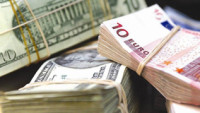 European markets managed to eke out a small gain yesterday after the ECB kept rates unchanged but left the door ajar to the prospect of a rate cut before the summer.
European markets managed to eke out a small gain yesterday after the ECB kept rates unchanged but left the door ajar to the prospect of a rate cut before the summer.
ECB President Christine Lagarde did push back strongly on speculation that policymakers had discussed anything like that insisting that such talk was premature, echoing her comments made earlier this month. It was noteworthy however that the possibility of a cut before June wasn’t ruled out completely, and it was that markets reacted to yesterday as yields declined sharply, which does keep the prospect of an earlier move on the table given how poor this week’s economic data has been.
US markets also managed to finish the day higher with the S&P500 and Nasdaq 100 putting in new record closes, after US Q4 GDP came in well above expectations at 3.3%.
The core PCE price index also remained steady at 2% for the second quarter in succession, and in line with the Federal Reserve’s inflation target, thus keeping faint hopes of a US rate cut in March alive.
It also places much greater importance on today’s December core PCE deflator inflation numbers which aren’t expected to vary much from what we saw in the November numbers.
At the moment markets seem convinced that the Fed might spring a surprise in March and slip in an early rate cut if inflation shows further signs of slowing. That might make sense if the US economy was struggling but this week’s economic numbers clearly suggest it isn’t, and if anything is still growing at a decent clip. There is a danger that in cutting rates in March they drive market expectations of further cuts into overdrive, something they have been keen to push back on with recent commentary.
In any case with the Federal Reserve due to meet next week markets are continuing to try and finesses the timing of when the first rate cut is likely to occur, after Powell’s surprisingly dovish shift when the central bank last met just before Christmas.
That means today PCE numbers are likely to be a key waypoint for markets and the central bank, after the PCE core deflator slowed to 3.2% in November, slipping from 3.4% in October, and the lowest level since April 2021.
A further slowdown to 3% or even lower, which appears to be the consensus could see markets continue to build on the prospect of a rate cut in March, which took hold back in December.
The bigger concern for some Fed officials is that headline CPI appears to be ticking higher again, which may make the last yards to 2% much trickier.
This will be the Fed’s key concern over an early cut as it could reignite the inflationary pressures that have taken so long to get under control. This caution would suggest that March is too early for a US rate cut, and that the market is getting ahead of itself, with policymakers also likely to pay attention to consumer demand.
This means personal spending is also likely to be a key indicator for the FOMC and here we are expecting to see a pickup to 0.5% from 0.2%. With the US consumer still looking resilient the Fed is likely to be extra cautious if inflation starts ticking higher again as it already has with headline CPI.
It was also interesting to note that while yields fell sharply yesterday, the US dollar didn’t, it actually finished the day higher and well off the lows of the week.
EUR/USD – slipped back towards the 200-day SMA at 1.0820/30 yesterday, with a break below 1.0800 targeting a potential move towards 1.0720. Resistance at the highs this week at 1.0930 and behind that at 1.1000.
GBP/USD – while the pound has struggled to push higher this week, we’ve managed to consistently hold above the support at the 50-day SMA as well as the 1.2590 area. We need to get above 1.2800 to maintain upside momentum.
EUR/GBP – finally slipped to support at the 0.8520 area, which needs to hold to prevent a move towards the August lows at 0.8490. Resistance at the 0.8620/25 area and the highs last week.
USD/JPY – currently finding resistance at the 148.80 area which has held over the last week or so which could see a move back towards the 146.25 area. A fall through 146.00 could delay a move towards 150 and argue for a move towards 144.00.












